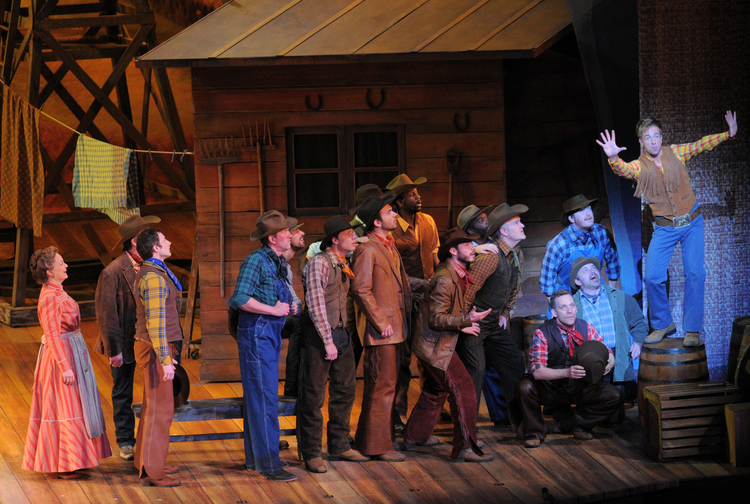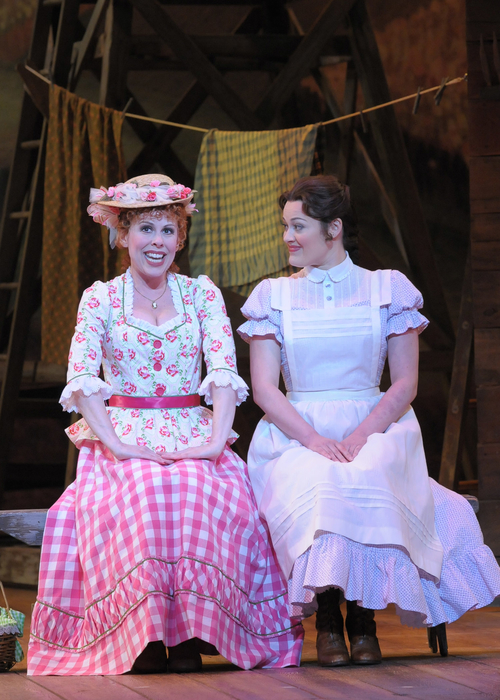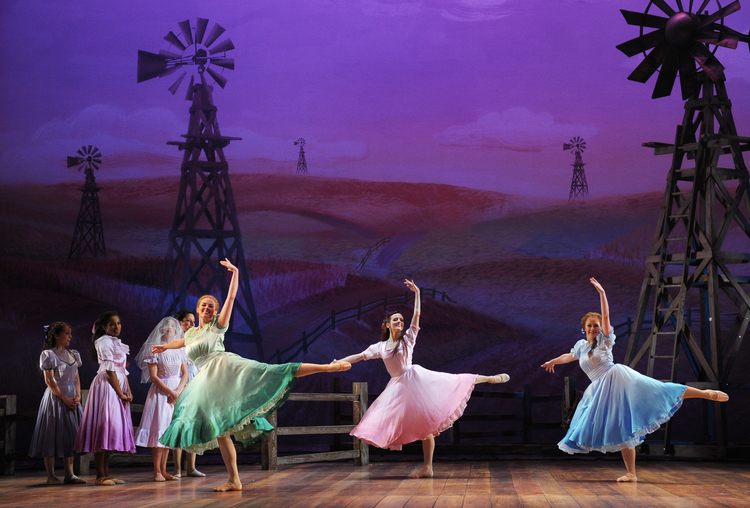May 29, 2020
Broadway goes West: Rodgers and Hammerstein’s OKLAHOMA!
Oklahoma! is one of the true miracles of American musical theater. This initial collaboration of composer Richard Rodgers and lyricist Oscar Hammerstein II isn’t simply a feast of memorable music and lyrics—it’s a pioneering, trailblazing masterpiece. Rather than “musical comedy,” its creators termed it a “musical play.” Little did they realize that they were producing a work that would transport the Broadway musical several giant steps forward.

The opening number of Oklahoma! in Lyric's 2012/13 production.
The whole idea of integrating song and story hadn’t really taken hold in musical theater until Hammerstein and composer Jerome Kern wrote Show Boat in 1927. Sixteen years later came Oklahoma!, where the element of dance was added as an essential component of a large-scale musical. Song, dance, and dialogue were blended with a seamlessness that musical theater hadn’t exhibited before. The show, however, was more than the sum of its parts, for it communicated a spirit—a positiveness—that transcended its basic musical and dramatic strengths. Oklahoma! truly invigorated a nation that was then fighting a world war. It gave Americans a palpable reason to hope for better times.
A young farm owner, Laurey, is being pursued by both the cowboy Curly and Jud, a surly farmhand who works for Laurey. The trouble starts when Curly gets Laurey’s hopes up by describing a fancy carriage in which he’s going to take her to the Box Social, but then confesses that he made it all up. This annoys Laurey, who impulsively chooses to attend the dance with Jud, although she’s somewhat frightened of him. The men’s rivalry for Laurey takes a deadly serious turn at the dance, with Jud’s behavior leading Laurey to fire him. Curly finally proposes to Laurey and she joyfully accepts, but their wedding celebration a few weeks later is marred by the sudden appearance of the violently jealous Jud. When he fights with Curly and falls on his knife, the local judge is persuaded to give Curly a verdict of self-defense, enabling the newlyweds to leave on their honeymoon. As they begin their new life together, they’re invigorated by the excitement that they can look forward to, living in a brand-new state.

Curtis Holbrook as Will Parker in Lyric's 2012/13 production of Oklahoma!.
The characters of Oklahoma! didn’t originate with Rodgers and Hammerstein. They came from Green Grow the Lilacs, a play by a native Oklahoman, Lynn Riggs, which New York’s most distinguished producing organization, The Theatre Guild, had presented on Broadway in 1931. That first production failed, but nine years later, at the Westport Playhouse in Connecticut, the play was staged again. Theresa Helburn, the Guild’s astute and resourceful co producer, was in the audience. Backstage she made the simple, straightforward, yet ultimately momentous statement—“This would make a good musical” —that set the Oklahoma! train on its track. Helburn proposed the idea to Rodgers, who couldn’t persuade his longtime writing partner, lyricist Lorenz Hart, to join him on the project.
Unbeknownst to Rodgers, Hammerstein had previously failed in his own attempt to interest composer Jerome Kern in a Green Grow the Lilacs musical. Rodgers called Hammerstein, Hammerstein agreed, and their work began. Up to this point Rodgers and Hammerstein had enjoyed considerable success with other collaborators. Rodgers and Hart had created a string of dazzlingly witty and tuneful hit shows, most prominently A Connecticut Yankee, Babes in Arms, Pal Joey, The Boys from Syracuse, and By Jupiter. Besides Kern in Show Boat, Hammerstein had created text for music by a variety of composers, triumphing with numerous highly romantic works written with Rudolf Friml (Rose Marie), Sigmund Romberg (The Desert Song, New Moon), and the long-dead Georges Bizet (whose Carmen was adapted brilliantly by Hammerstein to give Broadway Carmen Jones). Still, once the collaboration was launched with Oklahoma!, they seemed truly made for each other. Their artistry coalesced in a manner unsurpassed by any writing team in Broadway history.

Tari Kelly and Ashley Brown as Ado Annie and Laurey in Lyric's 2012/13 production of Oklahoma!.
Darling, this is the best musical show I have ever seen in my life.
Rodgers, Hammerstein, and their producing allies at The Theatre Guild had a horrendous time finding enthusiastic backers. One audition for funding followed another, with Hammerstein reading the dialogue and Rodgers at the piano, accompanying singers Joan Roberts and Alfred Drake (who would eventually create the show’s leading roles). No one thought the content of the story would be valid in a musical—and where were the jokes, the dances, and the big opening number that everyone expected? From the start, Rodgers was the only key player on the team who remained unshakably convinced that this was a potential hit. He had an invaluable cheering section in his wife, Dorothy. Shortly before the company of the show (then still going by the title Away We Go!) left New York for its first out-of-town tryout, Dorothy Rodgers was present for a now-legendary run-through of the show for an invited audience “Afterwards,” she recalled, “everyone got together to discuss what they thought. Dick put me in a cab. I went home and wrote a note which I put on his pillow. It said, ‘Darling, this is the best musical show I have ever seen in my life.’”
The New Haven performances were trying for the creators and performers in every possible way: cast and orchestra had very little time to rehearse together; the inappropriately fancy costumes needed extensive work to make them look more workaday; quite a few musical numbers underwent major adjustments; choreographer Agnes de Mille became ill (she would work with dancers while sitting in bed in her hotel room); and a general atmosphere of doom prevailed. This was only the second musical ever produced by The Theatre Guild, and the audience that trooped up to New Haven from New York came prepared for catastrophe. The show went over a good deal better than anyone had expected, yet the highly influential columnist Walter Winchell received a terse cable from his secretary that he inserted into his next column: “NO LEGS NO JOKES NO CHANCE.”
The director, Rouben Mamoulian, continued to work feverishly when the show went to Boston for its second tryout. A pointless tap number (!) for two of the dancers was eliminated, as was a beautiful ballad that had proven impossible to stage. It was called “Boys and Girls Like You and Me.” The number that replaced it, “People Will Say We’re in Love,” became not simply one of Rodgers and Hammerstein’s most celebrated songs, but also a hugely revealing moment in the developing relationship between the two main characters.
What lit the spark for the show was the realization, following the New Haven performances, that it needed a choral arrangement of a crucial song in Act Two. The duo had written that song to fulfill a desire Theresa Helburn had expressed to Hammerstein in New York, during the early stages of preparing the show: “I wish you and Dick could write a song about the earth…about the land.” The brilliant orchestrator/arranger, Robert Russell Bennett, created the arrangement on the train to Boston for the second tryout. The cast learned it in one day and, when introduced in performance, the Boston audience’s response was explosive. The show was retitled Oklahoma! and by the time it arrived on Broadway on March 31, 1943, it was ready to triumph.

The ensemble of Oklahoma! in Lyric's 2012/13 production.
The praise of both press and public assured the original production of an exceptional run of 2,212 performances—it didn’t close until mid-1948. That record for a musical on Broadway was to remain unchallenged until My Fair Lady exceeded it more than a decade later. Twelve years after the Broadway premiere came the captivating film version, which brought the show an international audience while making major stars of Gordon MacRae and Shirley Jones. Oklahoma! has since been staged in every possible venue, from high schools and church basements to London’s National Theatre, whose highly praised revival made it to Broadway in 2002.
Oklahoma!’s appeal begins, of course, with the matchless music and lyrics, but also with the total believability of every character. When someone bursts into song, inevitably the text and music suit that character ideally. The songs are utterly individual. It’s unimaginable that Ado Annie could sing Laurey’s “Many a New Day;” that song belongs to Laurey as surely as “I Cain’t Say No” belongs to Annie, “Oh, What a Beautiful Mornin” to Curly, and “Lonely Room” to Jud.
Each song is in itself a perfect marriage of song and lyrics. Rodgers rejoiced in producing the songs with his new collaborator:
The important thing is what we gave each other creatively. The very first lyric that Oscar finished was “Oh, What a Beautiful Mornin,” and when he handed it to me and I read it for the first time I was a little sick with joy because it was so lovely and so right. When you’re given lines like “The corn is as high as an elephant’s eye,” you get something to say musically.
The melodies may be comparatively limited in vocal range, but several of them require a legato as smoothly flowing as what you’d find in classic operatic repertoire.
From the show’s earliest days, its dance element has been essential in creating its visual and dramatic excitement. We owe this to choreographer Agnes de Mille, who came into the creative team at Rodgers and Hammerstein’s invitation (they knew her work from the spectacular ballet Rodeo, which had premiered in 1942). It was she who suggested turning the production team’s original idea of a circus ballet into a dream ballet, based on the idea of Laurey attempting to decide between Curly and Jud. Gorgeous dancing girls were invariably expected on Broadway, but in this case glamour didn’t matter to de Mille. She chose a corps of enormously exuberant, big-personality performers—young women who could both act and dance up a storm, matched by young men whose athleticism found its perfect outlet in “Kansas City” and “The Farmer and the Cowman.” The impact of Oklahoma! would have been radically lessened without de Mille’s imagination and astounding energy. Gemze de Lappe, de Mille’s longtime colleague who has remounted her work all over the world, took charge of the original Oklahoma! choreography for Lyric Opera’s new production in 2013.
Writing in Dance to the Piper (one of her several memorable volumes of autobiography), de Mille gave a description of the opening moments of the Broadway premiere. With a directness that was typical of her, she summed up what made Oklahoma! such an extraordinarily new experience seven decades ago:
The curtain went up on a woman churning butter; a very fine baritone onstage singing the closest thing to lieder our theater has produced. He sang exquisitely with his whole heart about what a morning in our Southwest is like. At the end, people gave an audible sigh and looked at one another–this had seldom happened before. It was music. They sat right back and opened their hearts. The show rolled.
American musical theater has gone in a great many directions since Oklahoma!, but it remains the seed from which this art form has grown. Its values transcend the passage of time, and the inspiration of its music and text remains undiminished.
Photos: Robert Kusel, Dan Rest
